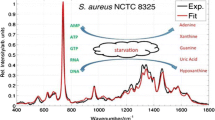Abstract
Vibrio fischeri andV. harveyi possess cytochromes a, b, and c, whereasPhotobacterium leiognathi andP. phosphoreum also contain cytochrome d. In all, cytochrome a as well as some of c binds carbon monoxide. Carbon monoxide does not inhibit bioluminescence (in vivo or in vitro), but carbonyl cyanidem-chlorophenylhydrazone inhibits only in vivo bioluminescence. This inhibition is due to dissipation of the proton motive force which indirectly inhibits bioluminescence by interruption of aldehyde recycling. Bioluminescence is thereby indirectly coupled to the proton motive force.
Similar content being viewed by others
Literature Cited
Antonini E, Brunori M (1971) Bacterial proteins with CO binding b- or c-type haem functions and absorption spectroscopy. Biochim Biophys Acta 768:293–320
Barnes EM Jr, Kaback HR (1973) Mechanisms of active transport in isolated membrane vesicles. I. The site of energy coupling betweend-lactic dehydrogenase and B-galactoside transport inE. coli membrane vesicles. J Biol Chem 246:5518–5522
Danilov VS, Malkov YA, Yegorow NS (1985) The effect of CO on the activity of bacterial luciferase. Stud Biophys 105:157–165
Eymers OG, van Shouwnburg KL (1936) On the luminescence of bacteria. II. Determination of the oxygen consumed in the light emitting process ofPhotobacterium phosphoreum. Enzymologia 1:238–340
Grogan DW (1984) Interaction of respiration and luminescence in a common marine bacterium. Arch Microbiol 137:159–162
Harold FM (1972) Conservation and transformation of energy by bacterial membranes. Bacteriol Rev 36:172–230
Hastings JW (1983) Biological diversity, chemical mechanisms and the evolutionary origins of bioluminescent systems. J Mol Evol 19:309–321
Hastings JW, Nealson KH (1977) Bacterial bioluminescence. Annu Rev Microbiol 31:549–595
Hastings JW, Nealson KH (1981) The symbiotic luminous bacteria. In: Starr MP, Stalp H, Trupper H, Balows A, Schlegel H (eds) The prokaryotes. A handbook on habitats, isolation and identification of bacteria. Berlin-Heidelberg: Springer Verlag, pp 1332–1345
Hastings JW, Weber G (1963) Total quantum flux of isotropic sources. J Opt Soc Am 53:1410–1415
Hastings JW, Baldwin TO, Nicoli MZ (1978) Bacterial luciferase: assay, purification and properties. Methods Enzymol 57:135–144
Heytter PG (1979) Uncouplers of oxidative phosphorylation. Methods Enzymol 55:462–472
Kamen MD, Torio T (1970) Bacterial cytochromes. I. Structural aspects. Annu Rev Biochem 39:673–700
Konishi K, Ouchi M, Kita K, Horikoshi I (1986) Purification of a cytochrome b560-d complex, a terminal oxidase of the aerobic respiratory chain ofPhotobacterium phosphoreum. J Biochem 99:1227–1236
Lombardi FJ, Reeves JP, Kaback HR (1973) Mechanisms of active transport in isolated bacterial membrane vesicles. VII. Valinomycin induced Rb transport. J Biol Chem 248:3551–3565
Makemson JC (1986) Luciferase-dependent oxygen consumption by bioluminescent vibrios. J Bacteriol 165:461–466
Makemson JC, Hastings JW (1979) Poising of the arginine pool and control of bioluminescence inBeneckea harveyi. J Bacteriol 140:532–542
Makemson JC, Hastings JW (1982) Iron represses bioluminescence inVibrio harveyi. Curr Microbiol 7:181–186
Makemson JC, Hastings JW (1986) Luciferase dependent growth of cytochrome-deficientVibrio harveyi. FEMS Microbiol Lett 38:79–85
Matsuyama T (1984) Staining of living bacteria with rhodamine 123. FEMS Microbiol Lett 21:153–157
Mitchell GW, Hastings JW (1971) A stable, inexpensive solid state photomultiplier-photometer. Anal Biochem 39:243–250
Poole RK (1983) Bacterial cytochrome oxidases. A structurally and functionally diverse group of electron transfer proteins. Biochim Biophys Acta 726:205–243
Reichelt JL, Baumann P (1973) Taxonomy of the marine luminous bacteria. Arch Mikrobiol 94:283–330
Resnick M, Schuldiner S, Bercovier H (1985) Bacterial membrane potential analyzed by spectrofluorocytometry. Curr Microbiol 12:183–186
Smith L (1970) Bacterial cytochromes and their spectra characteristics. Methods Enzymol 53:202–212
Watanabe H, Minura N, Takimoto A, Nakamura T (1975) Luminescence and respiratory activities ofPhotobacterium phosphoreum. J Biochem 77:1147–1155
Weston JA, Knowles CJ (1973) A soluble CO binding c-type cytochrome from the marine bacteriumbeneckea natriegens. Biochim Biophys Acta 305:11–18
Wood PM (1984) Bacterial proteins with CO binding b-or c-type haem functions and absorption spectroscopy. Biochim Biophys Acta 768:293–320
Author information
Authors and Affiliations
Rights and permissions
About this article
Cite this article
Guerrero, M.A., Makemson, J.C. The cytochromes of luminous bacteria and their coupling to bioluminescence. Current Microbiology 18, 67–73 (1989). https://doi.org/10.1007/BF01568834
Issue Date:
DOI: https://doi.org/10.1007/BF01568834




